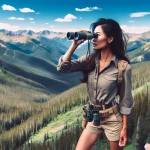Boulder weather’s mild climate, abundant sunshine, and proximity to nature make it an ideal destination for thrill-seekers, families, and anyone who loves the great outdoors.
In This Article
This article explores Boulder’s unique seasonal weather patterns and how they shape tourism and adventure sports throughout the year. You’ll discover the best times to visit to tailor activities from hiking to skiing, learn how to plan your trip according to forecasted conditions and gain safety tips for traveling in Colorado’s variable mountain weather. We’ll also examine the impacts of climate change on Boulder and efforts to protect its natural landscapes for future generations.
TL;DR
- Boulder's sunny climate and mountain location provide year-round outdoor recreation.
- Each season offers different adventures – skiing in winter, hiking, and biking as snow thaws.
- Check forecasts and understand weather risks before outdoor activities.
- Climate change brings hotter, drier summers and affects snowpack and ski seasons.
Overview of Boulder Weather and Climate
Boulder enjoys over 300 days of sunshine per year. Its climate is semi-arid, with precipitation varying greatly across seasons. Winters are cold but generally dry, while summers are hot with brief, intense thunderstorms. Boulder’s proximity to the Continental Divide leads to highly variable weather, especially in the mountains.
The city’s average high temperatures range from 45°F in January to 87°F in July. Nighttime lows drop below freezing even in summer. At higher mountain elevations, bitter cold, and deep snowpack persist from November through April.
Precipitation also fluctuates dramatically throughout the year. Boulder receives just 17 inches of rainfall annually, with May and June being the wettest. But moisture arrives violently via severe thunderstorms, flash flooding, and the occasional tornado. Snowfall primarily falls from October to April, with an annual average of 81 inches.
Cultural Highlights
Beyond adventure sports, Boulder offers a thriving arts scene, farm-to-table cuisine spotlighting Colorado produce, and a passion for sustainability and wellness. The city balances big-city amenities with a friendly college-town vibe, thanks to the University of Colorado’s influence.
Must-try experiences include wandering the pedestrian-only Pearl Street Mall, sampling local craft breweries, exploring the natural beauty of Chautauqua Park, and joining the enthusiastic crowds at a CU football game.
Seasonal Outdoor Activities
Boulder’s moderate climate translates to year-round access to the outdoors. Each season offers different adventures to match weather conditions.
Spring: Hiking and Cycling as Snows Thaw
March through May brings thawing snowpack, rain showers, and warm temperatures – perfect for moderate hiking and mountain biking. Trails that are snow-covered during winter start to reopen. Streams swell with snowmelt, presenting raging conditions for whitewater rafting.
Anglers flock to ice-free rivers and lakes to cast for trout. Rock climbing season kicks off as temperatures allow. Just be prepared for brief spring snow squalls that can turn trails icy.
Summer: Hot Days Fuel Peak Hiking and Water Fun
July and August are the hottest months, with temperatures frequently above 90°F and intense sun at high altitudes. Afternoon thunderstorms are common, so plan outdoor activities for early in the day.
Summertime favorites include hiking 14,000-foot peaks before storms roll in, mountain biking Boulder’s extensive trail network, tubing Boulder Creek, and escaping the heat by rafting Cache La Poudre River.
Fall: Crisp Air and Vibrant Foliage
Fall may be the peak season for visiting Boulder. September and October bring golden aspen leaves, crisp air, and clear sunny days. With students back at CU, Pearl Street and the famous Hill district come alive.
The fall hiking season reaches its peak with cooler temperatures and minimal precipitation. Mountain bike trails dry out after summer rains, while sport climbing remains excellent before winter cold arrives.
Winter: Powder Days and Apres Ski
From November through March, the Colorado Rockies transform into a frozen winter wonderland. Resorts like Eldora, Vail, and Breckenridge receive over 300 inches of light, dry snow – perfect for epic skiing and snowboarding.
Back in Boulder, holiday lights twinkle as the college town bundles up against below-freezing temperatures. Take advantage of bright bluebird days to snowshoe or cross-country ski at nearby trails. Then, cozy up next to a fireplace with hot cocoa in hand.
Weather Preparedness and Safety
To make the most of Boulder’s outdoor playground, travelers should understand common weather hazards and prepare accordingly. Altitude, intense sun exposure, rapidly changing mountain conditions, and extreme temperature swings all require caution.
Stay up to date with the local forecast at the Boulder Municipal Airport and monitor Colorado Avalanche Information Center reports before recreating in the backcountry. Pack layers, sun protection, emergency gear, and sufficient food and water. Know your limitations and avoid risks beyond your abilities.
Seeking local guidance can further enhance safety. Consider joining group hiking, skiing, or climbing excursions led by experienced professionals. Ask park rangers about trail conditions before heading out solo. Rent gear from local outfitters to ensure you have appropriate equipment.
Climate Change Impacts on Weather and Tourism
A warming climate threatens Boulder’s beloved outdoor identity. Since the 1970s, average temperatures have risen 2°F, and extreme heat waves now strike earlier. By 2050, Boulder may warm by another 5-10°F with three times more days above 95°F. Drier conditions will heighten wildfire risk.
At higher elevations, the snow season could shrink by weeks. Drought may persist for longer periods, drying forests and reducing autumn foliage. Declining snowpack affects winter tourism and ski resort revenues.
In response, Boulder has committed to an 80% emissions reduction by 2050. The city runs on 30% renewable electricity and hopes to fully decarbonize its power. Through transportation improvements, green building codes, and open space protections, Boulder aims to preserve its natural beauty despite climate shifts.
Planning Your Visit According to Weather
Since Boulder’s weather varies dramatically across seasons, checking forecasts is crucial when planning activities. The NOAA website provides detailed hourly and 15-day outlooks incorporating weather models, satellite imagery, and meteorologist input. Apps like Weather Underground and AccuWeather furnish real-time radar tracking storms.
It’s important to check the Boulder weather forecast for when you plan to visit. Checking for current things like temperature, air quality, severe weather, rain, snow showers, and future predictions on the weather map will help you plan accordingly.
Factor weather risks into transportation decisions as well. Give yourself flexible itineraries during the winter storm season or summer monsoon period. Rental cars may require snow tires or chains on mountain passes. And always build contingencies for outdoor adventures in case conditions turn hazardous.
Top Outdoor Activities for Thrill-Seekers
For adventurous travelers, Boulder is an outdoor playground offering boundless opportunities to challenge yourself in nature. Top activities include:
Hiking and Backpacking
Tackle a 14er, traverse wildflower-filled trails in the Indian Peaks, or wander through pine forests in Roosevelt National Forest.
Rock Climbing
Test your mettle on the iconic Flatirons sandstone slabs or limestone sport climbs in Boulder Canyon.
Mountain Biking
Ride lift-accessed downhill trails at Trestle Bike Park or explore over 100 miles of buffed singletrack around Boulder.
Skiing and Snowboarding
From gentle groomers at Eldora to steep chutes at backcountry destinations like Berthoud Pass.
Whitewater Rafting
Experience Class IV rapids on Clear Creek or the mellower float along Boulder Creek.
FAQ
What is the best time of year to visit Boulder?
Fall brings warm, sunny days and spectacular mountain scenery, while spring offers wildflower blooms and adventure as the snow thaws. But Boulder earns its “300 days of sun” reputation all year – each season has its perks!
What gear do I need to safely enjoy the outdoors around Boulder?
What you bring or wear may depend greatly on the Boulder weather forecast for the days you plan to be there. Check the weather map for potential severe weather, air quality, temperature, and other current weather conditions. Bring layers, sun protection (hat, sunglasses, lotion), proper footwear (hiking boots, water shoes), and other activity-specific equipment (backpack, climbing harness, bike helmet, etc.). Also, carry emergency supplies like a headlamp, space blanket, and first aid kit.
Where can I find up-to-date weather forecasts and snow conditions?
Check Boulder weather resources like the NOAA forecast, OpenSnow for ski conditions, the Colorado Avalanche Information Center, and local radar maps before any outdoor adventures.
How long does ski season last at Boulder resorts?
Colorado ski resorts normally open in mid-late November and run through April, depending on snowfall. At higher elevations, quality spring skiing can last into June.
What impact could climate change have on Boulder’s outdoor recreation and tourism industries?
Warmer temperatures may shorten ski seasons, reduce autumn foliage displays, and intensify summer heat and wildfire risks. However, Boulder is working to adapt through emissions reductions, renewable energy, and resource conservation.






